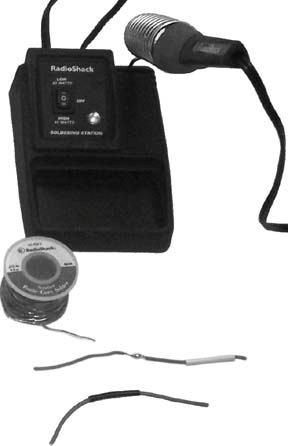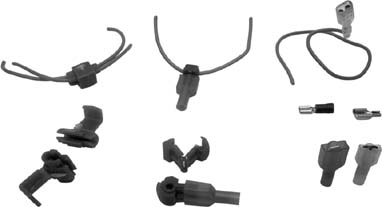Hack4.Connect Your Wires
Hack 4. Connect Your Wires
There are several ways to do in-car wiring: quick-and-dirty, functional, or professional, depending on who's going to see it and how long you want it to last. In the process of hacking computers and other devices into your car, you have to connect lots of wires. Unlike the inside of a computer, where all the wires are keyed and standardized, each car has its own set of connectors, and most of these are already in use. Except for cigarette lighter power outlets, which are really more for temporary connections, there is no standard "outlet" in the trunk of your car where you can seamlessly plug in your gadgets. What happens instead is that new wires are run to the locations where devices are installed. They are usually run under the floor carpet, or inside the plastic baseboards or framing at the edges of the seats and carpets. When the wires poke out, professional audio shops usually surround them with plastic sheathing and zip-tie them down, as shown in Figure 1-11. 1.5.1. Connecting WiresThere are several ways to connect all your wires. Which method you choose depends on how permanent a solution you want, your budget and tools, and how important appearances are to you. Figure 1-11. Tidy professional wiring 1.5.1.1 Twist and tape.The cheapest way to connect your wires is to twist them together and wrap electrical tape around them so they don't short out. This is the hallmark of an amateur, but it's my favored method when I am doing temporary installations or fixing or installing a radio while driving (er, not that I would do that). The minimal tools required for this approach are:
You need to strip the plastic coating off the wire in order to expose the metal wire strands that you will be twisting together. You should strip up to an inch of insulation, as you want lots of exposed metal to make as strong a connection as possible. Then you simply take the two wires you are connecting and twist them together, clockwise or counterclockwise. You then cover the whole thing with copious amounts of electrical tape. While this approach is extremely functional, it scores lowest on the scale of "gimped" to "crimped" to "pimped." 1.5.1.2 Solder and shrink.A much better, slower, but highly professional way to make permanent bonds between wires is to solder the connections. The tools required for this approach are:
The heat shrink is a plastic, cylindrical sleeve that you put over the soldered portion of the connection and then heat up. This causes the sleeve to shrink, cleanly covering the soldered area and making it look like one tidy contiguous wire. Make sure you cut the heat shrink long enough to cover the solder bond and reach both wire insulations, and that you slip it over one of the wires to be bonded before you connect them. Also, keep the heat shrink far down one of the wires, away from where you're solderingthe heat of the solder could preshrink your heat shrink and make it hard to work with. Figure 1-12 shows one step from this process. Figure 1-12. The solder-and-shrink method While this is no mini-course on soldering, the basic concepts here are that, being careful not to burn your hands, you place the two wires together, heat them up, and then put the solder on the wires. It will flow between all the wires (if they're braided) and make a nice solid bond. Then, after you've let the solder bond cool, you slide the heat shrink over the solder bond and heat it up quickly with the heat gun/hair dryer. One hack that people use in a pinch (with good porous heat shrink, not shiny smooth stuff) is simply to hold the heat shrink in the flame of a lighter. The heat shrink will shrivel into place if you heat it quickly and evenlyit's a skill similar to roasting marshmallows over a fire. 1.5.1.3 Crimp and save.There are a variety of very handy crimping approaches to wire bonding, and these are excellent in any situation where you are trying to tap into an existing ground or 12V wire that already goes somewhere and that you don't want to cut. We'll look at three kinds of wire crimps here. The tools required for this approach are:
One way to crimp wires together is to use a "piggyback" crimper (Figure 1-13, left). This small plastic and metal clamp can be put on one continuous wire, and another parallel wire can be bonded to it. You simply place both wires in the clip and crush it down. The metal in the crimp will slice through the insulation on both wires and connect them. Figure 1-13. A piggyback crimper, female blade plug tap, and blade plugs Another excellent crimp connector is a female blade plug tap (Figure 1-13, middle). This connector crimps onto an existing continuous wire and forms a T outlet that a male blade connector can tap into. This is excellent, say, if you've found 12V and ground wires in the trunk of your Dad's Lexus that you want to use to plug in some device, but you want to be as inconspicuous as possible in case he decides to take the car back to the dealer after you've blown several fuses. Male and female blade plugs (Figure 1-13, right) are classic crimp connectors. When professionally installed, they are good because they can be plugged and unplugged multiple times. This is important when a device is going to be uninstalled from time to time. However, the crimping tools you get with most handyman kits for these plugs tend to make such weak crimps that the ends pull off the wire on the first or second unplugging. Still, these are useful connectors, and some of them even come with their own plastic shielding, so you don't have to use electrical tape to insulate them. Damien Stolarz and Lionel Felix |